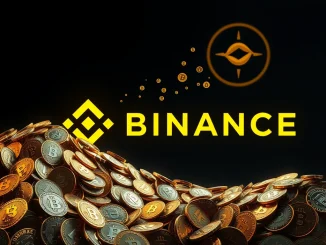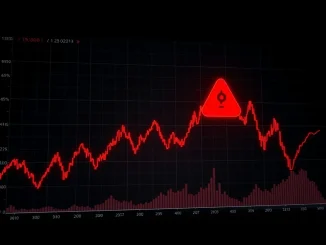
In the fast-paced world of cryptocurrency, it’s easy to get caught up in the latest token launches, blockchain updates, and price charts. But savvy investors know that the broader economic landscape plays a significant role. That’s why recent comments regarding US trade tariffs are worth paying attention to, even for those focused solely on digital assets.
What’s Happening with the Negotiation Deadline?
According to reports, Treasury Secretary Scott Bessent has indicated that the original July 9th deadline for certain trade tariff negotiations might be pushed back. This isn’t a definitive statement that the deadline *will* be extended, but the possibility alone introduces a layer of uncertainty into the economic outlook.
Here’s a quick breakdown:
- The Core News: US Treasury Secretary Scott Bessent mentioned the potential for extending a specific trade tariff negotiation deadline.
- Original Date: The deadline in question was reportedly set for July 9th.
- The Implication: An extension means ongoing talks and continued uncertainty around future trade relationships and tariffs.
While the specifics of which countries or tariffs are involved weren’t detailed in the initial report, the very notion of delaying a key economic negotiation can have ripple effects.
Understanding US Trade Tariffs and Their Purpose
Before diving into the implications, let’s briefly touch upon what US trade tariffs are. Tariffs are essentially taxes or duties imposed on imported goods or services. Governments use them for various reasons, including:
- Protecting domestic industries from foreign competition.
- Generating revenue for the government.
- Using them as leverage in trade negotiations.
- Responding to perceived unfair trade practices by other countries.
Negotiations around these tariffs involve complex discussions about trade balances, market access, intellectual property rights, and other economic policies between nations.
How Does Global Trade Policy Impact Markets?
Changes or uncertainty in global trade policy can significantly influence financial markets. Why? Because trade affects:
- Corporate Earnings: Companies that import or export goods are directly impacted by tariff costs and trade barriers.
- Consumer Prices: Tariffs can increase the cost of imported goods, potentially leading to inflation.
- Supply Chains: Trade disputes can disrupt established supply chains, affecting production and availability of goods.
- Investor Confidence: Uncertainty around trade policy can make investors hesitant, leading to volatility in stock markets and other asset classes.
Major developments in trade talks are often closely watched by investors worldwide as they can signal shifts in economic growth prospects and international relations.
The Potential Market Impact on Cryptocurrency
So, how does a potential delay in a trade tariff negotiation deadline relate to your crypto portfolio? While not a direct cause-and-effect like a specific crypto regulation, macroeconomic factors like trade policy influence broader market sentiment and liquidity. Here’s the connection:
- Risk Appetite: When there is economic uncertainty, investors often become more risk-averse. This can lead to a rotation out of riskier assets, which sometimes includes cryptocurrencies, and into perceived safer assets like bonds or cash.
- Dollar Strength: Global economic developments, including trade news, can affect the strength of the US dollar. A strong dollar can sometimes correlate with weaker performance in assets like Bitcoin, although this relationship is complex and not always consistent.
- Traditional Market Correlation: Bitcoin and other cryptocurrencies have shown increasing correlation with traditional markets, particularly the stock market (like the S&P 500 or Nasdaq). If trade uncertainty causes traditional markets to dip, crypto markets may follow suit due to interconnected sentiment and institutional involvement.
- Liquidity: Major shifts in economic policy or market sentiment can impact overall liquidity in the financial system, which can affect capital flows into and out of crypto markets.
The potential extension of the negotiation deadline means that the period of uncertainty surrounding these particular US trade tariffs continues. Markets generally dislike uncertainty, so this news could contribute to ongoing volatility or cautious sentiment in the near term.
Key Takeaways for Crypto Investors
While you don’t need to become a trade policy expert overnight, understanding these macro signals is beneficial. Here are some actionable insights:
- Stay Informed: Keep an eye on major economic news headlines, especially those involving significant policy discussions like trade tariffs.
- Recognize Interconnectedness: Understand that crypto markets do not exist in a vacuum and are increasingly influenced by global economic trends and traditional finance.
- Manage Risk: During periods of macro uncertainty, risk management becomes even more crucial. This might involve reviewing your portfolio allocation or setting stop-losses.
- Focus on Long-Term: For long-term crypto holders, short-term market reactions to macro news might be less concerning than the underlying technology and adoption trends, but they can still present buying opportunities during dips.
The comment from the Treasury Secretary is a reminder that factors beyond the immediate crypto ecosystem can impact prices and sentiment.
Conclusion: Watching the Trade Winds
The potential extension of the negotiation deadline for certain US trade tariffs, as mentioned by the Treasury Secretary, keeps global trade policy in the spotlight. This continued uncertainty can have a notable market impact, potentially influencing traditional financial markets and, by extension, the cryptocurrency space. While the direct link may not always be obvious, smart investors understand that the health and sentiment of the broader economy inevitably ripple through all asset classes, including digital ones. Keeping an eye on these developments is just another tool in navigating the complex investment landscape.



